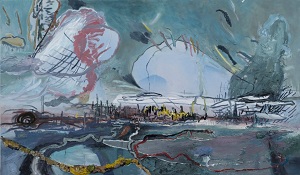
On first encountering Heller's work, one might be tempted to compare her views to Cormac McCarthy's ruined landscape in The Road, a post-apocalyptic, science-fiction tale that is also a harrowing yet deeply personal story. In McCarthy's world an unnamed catastrophe has scourged the landscape, which is inhabited by the last remnants of mankind and a small number of surviving dogs. The sky is perpetually shrouded by dust and toxic particulates; the seasons are merely varied intensities of cold and dampness. Trees have become extinct. Bands of cannibals roam the roads and inhabit what few dwellings remain intact in the woods. Grim stuff, to be sure, but underneath the horror McCarthy weaves a gentle story of a father and son.
Heller's painting presents a journey of sorts. Her cityscapes have something of this brutal feeling in their paint handling; yet, as in McCarthy's novel, the hard exterior belies an interior narrative that is personal, sensitive, and heartfelt. Speaking about her work, Heller says, "[I] think of New York as a character that's in action all the time…I [want] to make paintings of the life of the city, the way it moves."
Heller's paintings, such as "Old Souls in Pink and Aqua" (2013) [shown above] and "Rolling Thunder (Night for Day)" (2013), bear some slight resemblance to the early 1980s work of Enzo Cucchi. As in Cucchi's work, an open, ominous landscape stretches out before us, suggesting a long journey -- one most likely both physical and spiritual. Cucchi made many references to the travels of Arthur Rimbaud; Heller seems more willing to expose herself in her work. Her paintings seem to suggest not only that traveling changes the traveler, but that we have more than a slight impact on our environment as well. Architecture is diminished, and what is suggested might be faraway and abandoned; the road may lead to an oasis, but one more desolate than promising. The large, threatening cloud-like shapes that hover above might be seen as a personification of nature, benevolent and avenging angel rolled into one.
Traveling in a painting is not linear, and one must be willing to take the time to travel. Painting also embodies this place: the seeming contradiction between the thick stuff of paint (in all its finite opacity as the record of a mark having been made) and the volatile space or movement being suggested. Just like nothingness, or empty space, which is actually filled with energy and vibrating with electromagnetic fields and particles dancing in and out of existence, so also our thoughts and sights are connected to sensations and events that may not be visible to the naked eye but are no less real and recordable.
Magnan Metz Gallery is at 521 West 26th Street, New York, New York.
